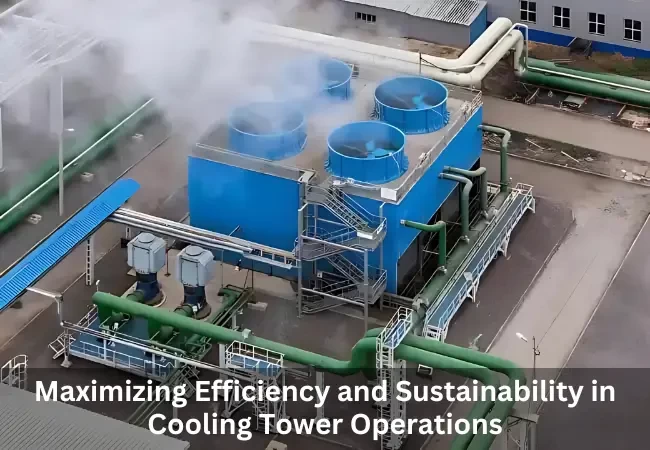Maximizing Efficiency and Sustainability in Cooling Tower Operations
Cooling towers are indispensable in industries and commercial buildings, yet they often remain out of sight and out of mind. Located in less-frequented areas, these systems are crucial for maintaining stable temperatures and ensuring seamless operations. However, unnoticed inefficiencies can lead to water wastage, increased energy consumption, and operational setbacks.
In this blog, we explore how optimizing cooling tower operations can enhance efficiency, conserve resources, and promote sustainability.
The Role of Cooling Towers in Industry
Cooling towers play a pivotal role in heat rejection from industrial processes and building systems. Whether in manufacturing, energy production, or HVAC systems, they help maintain operational stability. However, inefficiencies in these systems often manifest as:
High Water and Energy Consumption
- Water wastage due to uncontrolled makeup water flows or improper blowdown management.
- Increased energy demands due to inefficient heat exchange processes.
Bacterial Contamination Risks
- Insufficient biocide dosing leading to bacterial growth, posing safety risks and increasing maintenance costs.
Resource-Intensive Maintenance
- Manual interventions such as dosing and compliance reporting that require significant time and effort.
Common Challenges in Cooling Tower Management
Industries often face these challenges when managing cooling towers:
Ineffective Dosing Systems
Faulty dosing mechanisms can lead to under- or over-treatment of water, resulting in bacterial contamination or chemical wastage.
Lack of Real-Time Monitoring
Without continuous data collection and analysis, fluctuations in system performance go unnoticed, causing operational inefficiencies.
Misaligned Stakeholder Communication
Maintenance personnel, operators, and chemical suppliers may lack synchronized data, resulting in delayed responses to issues.
Solutions for Enhanced Cooling Tower Operations
To address these challenges, industries can adopt intelligent water management systems with the following features:
Automated Water Treatment
- Digital Dosing Pumps: Ensure precise chemical addition to maintain optimal water quality.
- Online Monitoring Systems: Track parameters like conductivity and dissolved solids in real-time to automate corrective actions.
Cloud-Based Control Systems
- Integrate operational data from all stakeholders, providing transparency and enabling better decision-making.
- Generate automated compliance reports, reducing manual effort and ensuring accuracy.
Proactive Maintenance and Alarms
Set alarms for issues like empty chemical tanks or abnormal water levels to prevent downtime and resource wastage.
Benefits of an Optimized Cooling Tower System
Water Conservation
Reduce unnecessary blowdown and prevent water losses from overflow or leaks.
Energy Savings
Enhance heat exchange efficiency, lowering energy requirements for cooling.
Enhanced Safety and Compliance
Maintain consistent bacterial control and reduce the risks associated with Legionella.
Operational Efficiency
Minimize manual interventions and reduce system downtime through predictive maintenance.
Conclusion
Optimizing cooling tower performance is not just about improving operational efficiency—it’s a step toward sustainability. By adopting intelligent solutions, industries can conserve resources, enhance safety, and align with global goals of water and energy conservation.
By focusing on better water management, industries can turn their cooling towers into assets that contribute significantly to both environmental and operational excellence.


